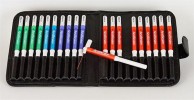Authors
T Xie, J Zhang, Z Kang, F Liu, Z Lin
Lab
Department of Neurosurgery, the First Affiliated Hospital of Fujian Medical University, Taijiang District, Fuzhou, 350005, Fujian, China
Journal
Neuroscience Research
Abstract
We aimed to demonstrate the effects of microRNA (miR)-101 on neuropathic pain and explore the underlying mechanisms. Rat spinal microglia cells were isolated and inflammatory condition was stimulated by 24-h incubation with lipopolysaccharide (LPS). Rats were divided into 4 groups: sham, chronic constriction injury (CCI), CCI_+_miR-negative control (miR-NC) and CCI_+_miR-101 mimics. Paw withdrawal threshold (PWT) and paw withdrawal latency (PWL) tests were conducted. The mRNA levels of key genes were determined by quantitative real-time polymerase chain reaction. Mammalian target of rapamycin (mTOR) protein level was detected by Western blot. Concentrations of interleukin (IL)-6, IL-1beta and tumor necrosis factor (TNF)-alpha were examined by ELISA. MiR-101 was downregulated and mTOR was upregulated in lumbar spinal dorsal horns from CCI rats. Targetscan and luciferase reporter assay confirmed that mTOR was direct target of miR101. MiR-101 mimics inhibited LPS-stimulated increase in the levels of IL-6, IL-1beta and TNF-alpha in primary microglial cells in vitro. In the rat CCI model, miR-101 mimics also suppressed CCI-induced decrease in PWT and PWL and inhibited CCI-induced increase in mRNA and protein levels of IL-6, IL-1beta and TNF-alpha. In addition, miR-101 downregulated mTOR mRNA and protein expressions in CCI rats. Besides, CCI operation resulted in miR-101 downregulation and mTOR mRNA upregulation in spinal microglia cells in a time-dependent manner. In conclusion, miR-101 had neuropathic pain-attenuating activity through targeting mTOR.
BIOSEB Instruments Used:
Von Frey Filaments (Bio-VF-M)

 Pain - Thermal Allodynia / Hyperalgesia
Pain - Thermal Allodynia / Hyperalgesia Pain - Spontaneous Pain - Postural Deficit
Pain - Spontaneous Pain - Postural Deficit Pain - Mechanical Allodynia / Hyperalgesia
Pain - Mechanical Allodynia / Hyperalgesia Learning/Memory - Attention - Addiction
Learning/Memory - Attention - Addiction Physiology & Respiratory Research
Physiology & Respiratory Research
 Pain
Pain Metabolism
Metabolism Motor control
Motor control Neurodegeneration
Neurodegeneration Cross-disciplinary subjects
Cross-disciplinary subjects Muscular system
Muscular system General activity
General activity Mood Disorders
Mood Disorders Other disorders
Other disorders Joints
Joints Central Nervous System (CNS)
Central Nervous System (CNS) Sensory system
Sensory system
